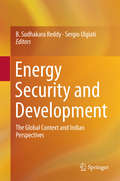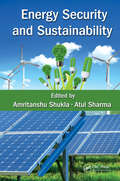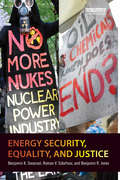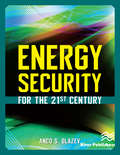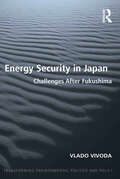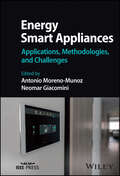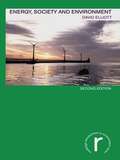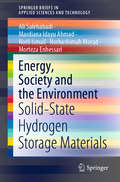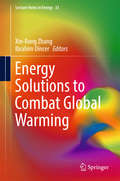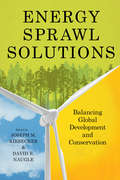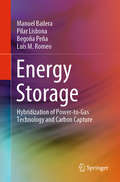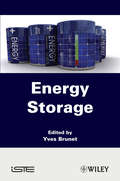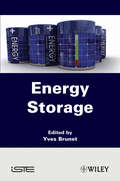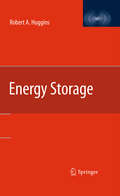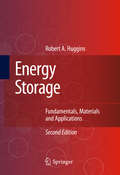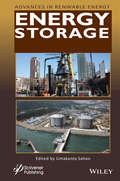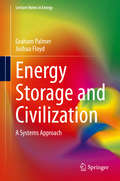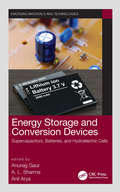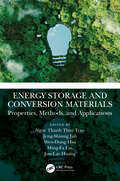- Table View
- List View
Energy Security and Development: The Global Context and Indian Perspectives
by B. Sudhakara Reddy Sergio UlgiatiThis volume provides a systematic framework for energy suppliers, policy makers, academics, students, and all others interested in energy security, and analyzes key issues concerning energy, security and sustainability with the help of a wealth of data. While sustainability is the broadest objective, energy security is an important part of it, at the global, national and societal levels. The development of a sustainable, long-term solution to meeting the world’s energy needs is a defining issue of our time, since central global challenges that the world faces—poverty alleviation, climate change, and environmental degradation—are directly linked to energy security. The contributions cover key issues in sustainable energy and illustrate that the insecurity of a majority of countries owes to internal factors which have more to do with market forces, inefficient technologies, lack of institutions, environmental insecurity, pricing mechanisms, etc., and less to do with the international situation.The links between energy and development are both direct and indirect. Directly, energy provides several services and utilities to maintain human well-being, and also does so indirectly through stakeholders. This volume addresses both the direct and indirect links and provides sustainable alternatives, helping readers to better grasp the resilience of both socio-economic and resource sub-systems in the process. The issues affecting energy supply and demand, including technology portfolios, environmental considerations and consumer attitudes are thoroughly discussed. One of the critical questions that arises is how to facilitate energy investment. The investment climate and the key issues involved are analyzed, including: the capital flows with reasonable and stable investment frameworks, timely decision-making by governments, and open markets. The broad objective of the volume is to foster a deeper understanding of the concept of energy security and to identify the methods of analysis, policy initiatives and future research needed to generate a balanced pattern of energy use and mitigate its impact on humanity and the environment.
Energy Security and Sustainability
by Amritanshu Shukla Atul SharmaThere has been ever increasing interest in understanding the various aspects of available resources and production, in terms of need and supply, conservation and environmental impacts and so on. From the current energy scenario, it is very clear that there are serious challenges related in achieving energy sustainability and security worldwide. The aim of this book is to present an overview of progress made towards energy sustainability addressing concerns regarding carbon emission and clean energy resources. Keeping this in mind, the book has chapters on all major energy sources which are being utilized at present, along with those having potential prospects for future.
Energy Security, Equality and Justice
by Benjamin K. Sovacool Roman V. Sidortsov Benjamin R. JonesThis book applies concepts from ethics, justice, and political philosophy to five sets of contemporary energy problems cutting across time, economics, politics, geography, and technology. In doing so, the authors derive two key energy justice principles from modern theories of distributive justice, procedural justice, and cosmopolitan justice. The prohibitive principle states that "energy systems must be designed and constructed in such a way that they do not unduly interfere with the ability of people to acquire those basic goods to which they are justly entitled." The affirmative principle states that "if any of the basic goods to which people are justly entitled can only be secured by means of energy services, then in that case there is also a derivative entitlement to the energy services." In laying out and employing these principles, the book details a long list of current energy injustices ranging from human rights abuses and energy-related civil conflict to energy poverty and pervasive and growing negative externalities. The book illustrates the significance of energy justice by combining the most up-to-date data on global energy security and climate change, including case studies and examples from the electricity supply, transport, and heating and cooking sectors, with appraisals based on centuries of thought about the meaning of justice in social decisions.
Energy Security, Equality and Justice
by Benjamin K. Sovacool Roman V. Sidortsov Benjamin R. JonesThis book applies concepts from ethics, justice, and political philosophy to five sets of contemporary energy problems cutting across time, economics, politics, geography, and technology. In doing so, the authors derive two key energy justice principles from modern theories of distributive justice, procedural justice, and cosmopolitan justice. The prohibitive principle states that "energy systems must be designed and constructed in such a way that they do not unduly interfere with the ability of people to acquire those basic goods to which they are justly entitled." The affirmative principle states that "if any of the basic goods to which people are justly entitled can only be secured by means of energy services, then in that case there is also a derivative entitlement to the energy services." In laying out and employing these principles, the book details a long list of current energy injustices ranging from human rights abuses and energy-related civil conflict to energy poverty and pervasive and growing negative externalities. The book illustrates the significance of energy justice by combining the most up-to-date data on global energy security and climate change, including case studies and examples from the electricity supply, transport, and heating and cooking sectors, with appraisals based on centuries of thought about the meaning of justice in social decisions.
Energy Security for the 21st Century
by Anco S. BlazevThis book takes a very close look at energy and energy security from a hands-on, technical point of view with an ultimate goal of sorting out and explaining the deep meaning of energy as well as the key factors and variables of our energy security. The book reviews the major energy sources—coal, crude oil, natural gas, the renewables, and other alternative fuels and technologies—according to the way they affect our energy security now and what consequences might be expected in the future. Topics include the different technical, logistics, regulatory, social, political, and financial aspects of modern energy products and technologies. The advantages and disadvantages of the different fuels, technologies, energy strategies, regulations, and policies are reviewed in detail, sorted, and clearly laid out as well as their effects on our present and future energy security in a way that is easy to understand by high school students, engineers, and professors alike. This book is a must-read for energy executives, environmental specialists, investors, bankers, lawyers, regulators, politicians, and anyone involved, or interested, in today’s energy production and use and their effects on our energy security.
Energy Security in Japan: Challenges After Fukushima (Transforming Environmental Politics and Policy)
by Vlado VivodaFor a country already uneasy about energy security, the 2011 earthquake and tsunami, which caused a nuclear catastrophe at the Fukushima nuclear power plant, turned pre-existing Japanese concern about the availability of energy into outright anxiety. The subsequent closure of many nuclear reactors meant Japan needed to replace lost power quickly and so had no choice but to secure additional fossil fuels, undermining Japanese diversification policy and increasing global and regional competition for energy. This switch has been at a cost to the already weak Japanese economy whilst the increase in fossil fuel consumption has caused a significant increase in greenhouse gas emissions. In this book Vlado Vivoda examines the drastically changed environment following the disaster in order to analyse Japan’s energy security challenges and evaluate Tokyo’s energy policy options. Looking at how the disaster exacerbated Japan’s existing energy security challenges, Vivoda considers the best policy options for Japan to enhance national energy security in the future, exploring the main impediments to change and how they might be overcome.
Energy Security in Japan: Challenges After Fukushima (Transforming Environmental Politics and Policy)
by Vlado VivodaFor a country already uneasy about energy security, the 2011 earthquake and tsunami, which caused a nuclear catastrophe at the Fukushima nuclear power plant, turned pre-existing Japanese concern about the availability of energy into outright anxiety. The subsequent closure of many nuclear reactors meant Japan needed to replace lost power quickly and so had no choice but to secure additional fossil fuels, undermining Japanese diversification policy and increasing global and regional competition for energy. This switch has been at a cost to the already weak Japanese economy whilst the increase in fossil fuel consumption has caused a significant increase in greenhouse gas emissions. In this book Vlado Vivoda examines the drastically changed environment following the disaster in order to analyse Japan’s energy security challenges and evaluate Tokyo’s energy policy options. Looking at how the disaster exacerbated Japan’s existing energy security challenges, Vivoda considers the best policy options for Japan to enhance national energy security in the future, exploring the main impediments to change and how they might be overcome.
Energy Smart Appliances: Applications, Methodologies, and Challenges
by Antonio Moreno-Munoz Neomar GiacominiEnergy Smart Appliances Enables designers and manufacturers to manage real-world energy performance and expectations by covering a range of potential scenarios and challenges Energy Smart Appliances provides utilities and appliance manufacturers, and designers with new approaches to better understand real-world performance, assess actual energy benefits, and tailor each technology to the needs of their customers. With contributions from a fully international group of experts, including heads of prestigious research organizations and leading universities, and innovation managers of the main appliance manufacturers, Energy Smart Appliances includes discussion on: Enabling technologies for energy smart appliances, covering IoT devices and technology and active energy efficiency measures in residential environments Smart home and appliances, answering questions like ‘Where are we heading in terms of the overall smart homes’ future?’ and ‘What’s the energy impact from smart home devices?’ Demand-side management and demand response, covering overall system/ appliances readiness and ideal energy management scenario to drive demand response Energy smart appliances’ best practices and success stories, including refrigerators, washers, dryers, and more With practical coverage of a wide range of potential scenarios and existing and future challenges, Energy Smart Appliances is an essential learning resource for electrical engineering professionals, equipment manufacturers, and designers, along with postgraduate electrical engineering students and researchers in related fields and programs of study.
Energy Smart Appliances: Applications, Methodologies, and Challenges
by Antonio Moreno-Munoz Neomar GiacominiEnergy Smart Appliances Enables designers and manufacturers to manage real-world energy performance and expectations by covering a range of potential scenarios and challenges Energy Smart Appliances provides utilities and appliance manufacturers, and designers with new approaches to better understand real-world performance, assess actual energy benefits, and tailor each technology to the needs of their customers. With contributions from a fully international group of experts, including heads of prestigious research organizations and leading universities, and innovation managers of the main appliance manufacturers, Energy Smart Appliances includes discussion on: Enabling technologies for energy smart appliances, covering IoT devices and technology and active energy efficiency measures in residential environments Smart home and appliances, answering questions like ‘Where are we heading in terms of the overall smart homes’ future?’ and ‘What’s the energy impact from smart home devices?’ Demand-side management and demand response, covering overall system/ appliances readiness and ideal energy management scenario to drive demand response Energy smart appliances’ best practices and success stories, including refrigerators, washers, dryers, and more With practical coverage of a wide range of potential scenarios and existing and future challenges, Energy Smart Appliances is an essential learning resource for electrical engineering professionals, equipment manufacturers, and designers, along with postgraduate electrical engineering students and researchers in related fields and programs of study.
Energy, Society and Environment (Routledge Introductions to Environment: Environment and Society Texts)
by David ElliottSociety's use of energy and technology is at heart of many of the most significant environmental problems of recent years, including problems of health, global warming and acid rain. Use of technology has been a major cause of environmental problems but new technology offers many solutions.Energy, Society and Environment is an introduction to energy and energy use, and the interactions between technology, society and the environment. The book is clearly structured to examine:* key environmental issues, and the harmful impacts of energy use* new technological solutions to environmental problems* implementation of possible solutions* implications for society in developing a sustainable approach to energy use.Social processes and strategic solutions to problems are located within a clear, technological context with topical case studies and informative diagrams illustrating key issues.Energy, Society and Environment examines the potential and limits of technical solutions to environmental problems and suggests the social, economic and political changes necessary to avoid serious environmental damage in the future.
Energy, Society and Environment (Routledge Introductions to Environment: Environment and Society Texts)
by David ElliottSociety's use of energy and technology is at heart of many of the most significant environmental problems of recent years, including problems of health, global warming and acid rain. Use of technology has been a major cause of environmental problems but new technology offers many solutions.Energy, Society and Environment is an introduction to energy and energy use, and the interactions between technology, society and the environment. The book is clearly structured to examine:* key environmental issues, and the harmful impacts of energy use* new technological solutions to environmental problems* implementation of possible solutions* implications for society in developing a sustainable approach to energy use.Social processes and strategic solutions to problems are located within a clear, technological context with topical case studies and informative diagrams illustrating key issues.Energy, Society and Environment examines the potential and limits of technical solutions to environmental problems and suggests the social, economic and political changes necessary to avoid serious environmental damage in the future.
Energy, Society and the Environment: Solid-State Hydrogen Storage Materials (SpringerBriefs in Applied Sciences and Technology)
by Ali Salehabadi Mardiana Idayu Ahmad Norli Ismail Norhashimah Morad Morteza EnhessariThis book provides a comprehensive and contemporary overview of advances in energy and energy storage technologies. Although the coverage is varied and diverse, the book also addresses unifying patterns and trends in order to enrich readers’ understanding of energy and energy storage systems, particularly hydrogen energy storage, including e.g. their morphology, porosity and material structure. Readers will also gain insights into the hydrogen storage performance landscape, based on data released by the US Department of Energy (DOE), providing a basis for understanding real-world applications. The book also discusses the superior hydrogen storage performance of solid-state materials and explores the physical and chemical properties that can potentially affect their performance.
Energy Solutions to Combat Global Warming (Lecture Notes in Energy #33)
by XinRong Zhang Ibrahim DincerThis book gathers an in-depth collection of 45 selected papers presented at the Global Conference on Global Warming 2014 in Beijing, China, covering a broad variety of topics from the main principles of thermodynamics and their role in design, analysis, and the improvements in performance of energy systems to the potential impact of global warming on human health and wellbeing. Given energy production’s role in contributing to global warming and climate change, this work provides solutions to global warming from the point of view of energy. Incorporating multi-disciplinary expertise and approaches, it provides a platform for the analysis of new developments in the area of global warming and climate change, as well as potential energy solutions including renewable energy, energy efficiency, energy storage, hydrogen production, CO2 capture and environmental impact assessment. The research and analysis presented herein will benefit international scientists, researchers, engineers, policymakers and all others with an interest in global warming and its potential solutions.
Energy Sprawl Solutions: Balancing Global Development and Conservation
by Joseph M. Kiesecker and David E. NaugleThe editors provide a roadmap for preserving biodiversity despite the threats of energy sprawl. Their strategy—development by design—brings together companies, communities, and governments to craft blueprints for sustainable land development. This commonsense approach identifies and preemptively sets aside land where biodiversity can thrive while consolidating development in areas with lower biodiversity value. This approach makes sense for energy industries and governments, which can confidently build sustainability into their energy futures.
Energy Storage: Hybridization of Power-to-Gas Technology and Carbon Capture (Springerbriefs In Energy Ser.)
by Manuel Bailera Pilar Lisbona Begoña Peña Luis M. RomeoThis book presents a detailed analysis of Power-to-Gas, a promising energy storage technology. It discusses the main mechanisms involved, and presents two Power-to-Gas and carbon capture hybridizations. The book begins by providing an introduction to energy storage technologies. It then reviews a number of Power-to-Gas projects now in progress, highlighting the current barriers to commercializing the technology. Moreover, the book presents two novel Power-to-Gas hybridizations, which improve the technology’s applicability in terms of efficiency, utilization of resources and profitability. Given its scope, the book will be of interest to graduate students, researchers and practitioners in the fields of engineering and energy.
Energy Storage
by Yves BrunetEnergy storage examines different applications such as electric power generation, transmission and distribution systems, pulsed systems, transportation, buildings and mobile applications. For each of these applications, proper energy storage technologies are foreseen, with their advantages, disadvantages and limits. As electricity cannot be stored cheaply in large quantities, energy has to be stored in another form (chemical, thermal, electromagnetic, mechanical) and then converted back into electric power and/or energy using conversion systems. Most of the storage technologies are examined: batteries, hydrogen, super capacitors, SMES, flywheels, CAES, thermal storage and hydraulic gravitational storage.
Energy Storage
by Yves BrunetEnergy storage examines different applications such as electric power generation, transmission and distribution systems, pulsed systems, transportation, buildings and mobile applications. For each of these applications, proper energy storage technologies are foreseen, with their advantages, disadvantages and limits. As electricity cannot be stored cheaply in large quantities, energy has to be stored in another form (chemical, thermal, electromagnetic, mechanical) and then converted back into electric power and/or energy using conversion systems. Most of the storage technologies are examined: batteries, hydrogen, super capacitors, SMES, flywheels, CAES, thermal storage and hydraulic gravitational storage.
Energy Storage: Fundamentals, Materials And Applications
by Robert HugginsIntroduction Energy is necessary for a number of reasons, the most basic and obvious involve the preparation of food and the provision of heat to make life comfortable, or at least, bearable. Subsequently, a wide range of technological uses of energy have emerged and been developed, so that the availability of energy has become a central issue in society. The easiest way to acquire useful energy is to simply ?nd it as wood or a hydrocarbon fossil fuel in nature. But it has often been found to be advantageous to convert what is simply available in nature into more useful forms, and the processing and conversion of raw materials, especially petrochemicals have become a very large industry. Wood Wood has been used to provide heat for a great many years. In some cases, it can be acquired as needed by foraging, or cutting, followed by simple collection. When it is abundant there is relatively little need for it to be stored. However, many societies have found it desirable to collect more wood than is immediately needed during warm periods during the year, and to store it up for use in the winter, when the needs are greater, or its collection is not so convenient. One can still see this in some locations, such as the more remote communities in the Alps, for example. One might think of this as the oldest and simplest example of energy storage.
Energy Storage: Fundamentals, Materials and Applications
by Robert HugginsEnergy Storage explains the underlying scientific and engineering fundamentals of all major energy storage methods. These include the storage of energy as heat, in phase transitions and reversible chemical reactions, and in organic fuels and hydrogen, as well as in mechanical, electrostatic and magnetic systems. Updated coverage of electrochemical storage systems considers exciting developments in materials and methods for applications such as rapid short-term storage in hybrid and intermittent energy generation systems, and battery optimization for increasingly prevalent EV and stop-start automotive technologies. This nuanced coverage of cutting-edge advances is unique in that it does not require prior knowledge of electrochemistry. Traditional and emerging battery systems are explained, including lithium, flow and liquid batteries. Energy Storage provides a comprehensive overview of the concepts, principles and practice of energy storage that is useful to both students and professionals.
Energy Storage (Advances In Renewable Energy Ser.)
by Umakanta SahooThe world’s energy landscape is very complex. Fossil fuels, especially because of hydraulic fracturing, are still a mainstay of global energy production, but renewable energy sources, such as wind, solar, and others, are increasing in importance for global energy sustainability. Experts and non-experts agree that the next game-changer in this area will be energy storage. Energy storage is crucial for continuous operation of power plants and can supplement basic power generation sources over a stand-alone system. It can enhance capacity and leads to greater security, including continuous electricity supply and other applications. A dependable energy storage system not only guarantees that the grid will not go down, but also increases efficacy and efficiency of any energy system. This groundbreaking new volume in this forward thinking series addresses all of these issues, laying out the latest advances and addressing the most serious current concerns in energy storage. Whether for the veteran engineer or the student, this latest volume in the series, “Advances in Renewable Energy,” is a must-have for any library.
Energy Storage (Advances In Renewable Energy Ser.)
by Umakanta SahooThe world’s energy landscape is very complex. Fossil fuels, especially because of hydraulic fracturing, are still a mainstay of global energy production, but renewable energy sources, such as wind, solar, and others, are increasing in importance for global energy sustainability. Experts and non-experts agree that the next game-changer in this area will be energy storage. Energy storage is crucial for continuous operation of power plants and can supplement basic power generation sources over a stand-alone system. It can enhance capacity and leads to greater security, including continuous electricity supply and other applications. A dependable energy storage system not only guarantees that the grid will not go down, but also increases efficacy and efficiency of any energy system. This groundbreaking new volume in this forward thinking series addresses all of these issues, laying out the latest advances and addressing the most serious current concerns in energy storage. Whether for the veteran engineer or the student, this latest volume in the series, “Advances in Renewable Energy,” is a must-have for any library.
Energy Storage and Civilization: A Systems Approach (Lecture Notes in Energy #40)
by Graham Palmer Joshua FloydFossil fuels comprise the accumulation of prehistoric biomass that was energised by sunlight, and formed by earth system dynamics. Fossil fuels can be conceptualized as stored energy stocks that can be readily converted to power flows, on demand. A transition from a reliance on stored energy stocks, to renewable energy flows, will require a replication of energy storage by technological devices and energy conversion methods. Most analyses of energy storage focus solely on the economic-technical properties of storage within incumbent energy systems. This book broadens the scope of the study of storage by placing it within a broader, historical, biophysical framework. The role and value of storage is examined from first principles, and framed within the contemporary context of electrical grids and markets. The energy-economic cost of electrical storage may be critical to the efficacy of high penetration renewable scenarios, and understanding the costs and benefits of storage is needed for a proper assessment of storage in energy transition studies. This book provides a starting point for engineers, scientists and energy analysts for exploring the role of storage in energy transition studies, and for gaining an appreciation of the biophysical constraints of storage.
Energy Storage and Conversion Devices: Supercapacitors, Batteries, and Hydroelectric Cells (Emerging Materials and Technologies)
by Anurag GaurThis book presents a state-of-the-art overview of the research and development in designing electrode and electrolyte materials for Li-ion batteries and supercapacitors. Further, green energy production via the water splitting approach by the hydroelectric cell is also explored. Features include: • Provides details on the latest trends in design and optimization of electrode and electrolyte materials with key focus on enhancement of energy storage and conversion device performance • Focuses on existing nanostructured electrodes and polymer electrolytes for device fabrication, as well as new promising research routes toward the development of new materials for improving device performance • Features a dedicated chapter that explores electricity generation by dissociating water through hydroelectric cells, which are a nontoxic and green source of energy production • Describes challenges and offers a vision for next-generation devices This book is beneficial for advanced students and professionals working in energy storage across the disciplines of physics, materials science, chemistry, and chemical engineering. It is also a valuable reference for manufacturers of electrode/electrolyte materials for energy storage devices and hydroelectric cells.
Energy Storage and Conversion Devices: Supercapacitors, Batteries, and Hydroelectric Cells (Emerging Materials and Technologies)
by Anurag Gaur A. L. Sharma Anil AryaThis book presents a state-of-the-art overview of the research and development in designing electrode and electrolyte materials for Li-ion batteries and supercapacitors. Further, green energy production via the water splitting approach by the hydroelectric cell is also explored. Features include: • Provides details on the latest trends in design and optimization of electrode and electrolyte materials with key focus on enhancement of energy storage and conversion device performance • Focuses on existing nanostructured electrodes and polymer electrolytes for device fabrication, as well as new promising research routes toward the development of new materials for improving device performance • Features a dedicated chapter that explores electricity generation by dissociating water through hydroelectric cells, which are a nontoxic and green source of energy production • Describes challenges and offers a vision for next-generation devices This book is beneficial for advanced students and professionals working in energy storage across the disciplines of physics, materials science, chemistry, and chemical engineering. It is also a valuable reference for manufacturers of electrode/electrolyte materials for energy storage devices and hydroelectric cells.
Energy Storage and Conversion Materials: Properties, Methods, and Applications
by Tran, Ngoc Thanh Thuy Jeng-Shiung Jan Wen-Dung Hsu Ming-Fa Lin Jow-Lay HuangThis book explores the fundamental properties of a wide range of energy storage and conversion materials, covering mainstream theoretical and experimental studies and their applications in green energy. It presents a thorough investigation of diverse physical, chemical, and material properties of rechargeable batteries, supercapacitors, solar cells, and fuel cells, covering the development of theoretical simulations, machine learning, high-resolution experimental measurements, and excellent device performance. Covers potential energy storage (rechargeable batteries and supercapacitors) and energy conversion (solar cells and fuel cells) materials Develops theoretical predictions and experimental observations under a unified quasi-particle framework Illustrates up-to-date calculation results and experimental measurements Describes successful synthesis, fabrication, and measurements, as well as potential applications and near-future challenges Promoting a deep understanding of basic science, application engineering, and commercial products, this work is appropriate for senior graduate students and researchers in materials, chemical, and energy engineering and related disciplines.
